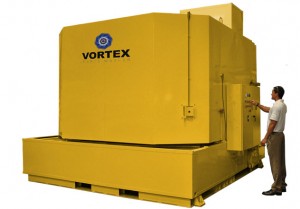Aircraft Parts Cleaning Systems
 Vortex Parts Washers are the product of a professional design team with decades of parts washer manufacturing, service and sales experience. Vortex Parts Washers provide the most powerful and precise cleaning of all heavily soiled parts in the industry; dependability, power, and the performance of single, dual, or quadroplex high horsepower pumps ensure that all parts are thoroughly cleaned throughout the part’s crevasses, pockets, and surface areas.
Vortex Parts Washers are the product of a professional design team with decades of parts washer manufacturing, service and sales experience. Vortex Parts Washers provide the most powerful and precise cleaning of all heavily soiled parts in the industry; dependability, power, and the performance of single, dual, or quadroplex high horsepower pumps ensure that all parts are thoroughly cleaned throughout the part’s crevasses, pockets, and surface areas.
Aircraft Parts Cleaning Systems
By Paul Seidenman and David Spanovich
Aviationweek.com
Automated parts cleaning cuts costs, improves quality control and saves time.
For aircraft parts cleaning, more MRO operators are discovering what their mothers have known for decades: There’s no need to scrub by hand when machines can do the work automatically. Just as home washing machines and dishwaters took the time-consuming drudgery out of cleaning clothes or dinner plates, many off-the-shelf industrial cleaning systems do the same with aircraft parts, with little or no modification required. Using these systems provides MROs major reductions in cleaning cycle times, improved quality control, a huge savings on waste disposal costs, and greater repair capacity, because technicians are free to perform other tasks. Just as important, the new systems are environmentally friendly and raise no occupational health issues.
“Manual parts cleaning methods, using chemical solvents in wash tubs, present health and environmental hazards,” said Robert Lye, vice-president of Landa Cleaning Systems. “Mechanics are exposed to harmful vapors and dangerous contaminants that are absorbed into the blood stream through the skin.”
Manual cleaning also is extremely time consuming and costly: “That’s why we have seen double-digit growth with sales to the aviation MRO industry of parts washers using water/detergent solutions, especially over the past three years.”
Operational efficiency and environmental concerns were, in fact, among the reasons why United Services acquired a Landa Cleaning Systems SJ-15C-S top loader washer to clean main engine starter units at its San Francisco International Airport maintenance center. Robert Primer, a United Services engine technician, explained that the system, procured in January, is an off-the-shelf product that needed no modifications for its application at United. Similar to an automatic dishwasher, the machine uses a 360-degree spin rotary nozzle to spray a commercial detergent mixed with water over the parts, which are contained in a stationary basket.
“The greasy sludge is automatically skimmed off from the rest of the solution for disposal into containers,” Primer said. “The solution, itself, can be reused for as many as 50 wash cycles before it needs to be drained and replaced.”
Goodrich uses this Graymills tank to do pre-and post-wash rinsing on DC generators.Credit: Goodrich
In addition to being environmentally friendly, the automated washer accommodates up to three engine starter units per-cycle and takes about 20 minutes for completion, compared with the 90 minutes usually required when cleaning parts by hand. Primer added that it also has eliminated the leg work.
“The manual system required the technician to leave his work cell and go to another area of the shop to clean the sludge from the disassembled starter unit components; then return them to the work cell for reassembly. Now, all the technician has to do is load those components into the washer, which is in the work cell. This frees the technician for other tasks while they are being cleaned.”
The automated washer, in tandem with Lean manufacturing methods applied to the engine starter unit work cells, has helped United reduce cycle times by as much as 25 percent, said Rod Fennell, United Services’ mechanical and electrical accessories manager. “The system does a consistent cleaning job yet uses less manpower. It is also more process oriented, making us more competitive with other MRO shops.”
